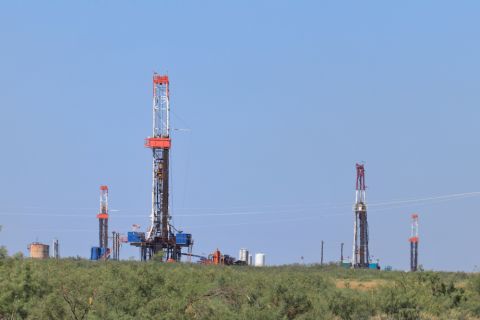In the wake of Anadarko Petroleum's aggregate $23.3-billion, all-cash bid for Kerr-McGee Corp. and Western Gas Resources, energy analysts on Wall Street have reached a consensus: more major upstream combinations are in the offing. Brian M. Gibbons Jr., senior oil and gas analyst with CreditSights, an independent equity and debt research firm in New York, says Anadarko's recent move has sent an undeniable message to industry competitors: it's time to either start buying-and buying big-or risk being bought, or even worse, risk being left in the dust to lock up large-scale resource plays. What triggered the double-barreled bid by Anadarko? Clearly, the recent sharp drop in the stock-market values of Kerr-McGee and Western Gas produced an unusual opportunity to get undervalued assets on a per-share basis. And, with commodity-price hedges protecting the bulk of the proposed acquisitions' cash flows and the likelihood of subsequent asset sales, Anadarko could well afford to offer hefty 40% and 49% premiums, respectively, over Kerr-McGee's and Western Gas' late June stock prices. But the dual bid was also motivated by Anadarko's lack of a true legacy asset, opines one leading Houston E&P analyst. "Its divestiture program over the past few years had left the company with a scattered base of assets, none of which were particularly needle-movers for the producer. "So it needed to become dominant in high-potential areas that can drive rapid growth," the analyst explains. "Two of the least mature and exploited areas in North America are the deepwater Gulf of Mexico and the Rockies-and arguably Anadarko is buying through Kerr-McGee and Western Gas the two best and most undervalued assets in those respective areas. Going forward, we see more upstream M&A-and those with attractive resource plays are going to be in the cross-hairs of acquirers." Bernard J. Picchi, senior managing director and energy analyst for Foresight Research Solutions LLC, a New York-based independent research firm, says a big disconnect exists between the values that acquirers see in merger candidates and the stock market's valuations of those candidates. After applying Anadarko's per-barrel enterprise valuation of Kerr-McGee's reserves-$18.63 per barrel of oil equivalent (BOE)-to the proved reserves of 25 North American independents, Picchi determined that the five most undervalued names are Pioneer Natural Resources, Whiting Petroleum, Plains Exploration & Production, Anadarko itself and Pogo Producing. CreditSights' Gibbons believes that among the largest North American E&P companies-those with 800 million to 1.3 billion BOE of reserves-Devon Energy, EOG Resources, Chesapeake Energy and Noble Energy are immediate M&A candidates, either as acquirers or acquirees. He notes, in particular, that Devon and EOG have very strong balance sheets. Among companies with proved reserves in the 200- to 400-million-BOE range, Plains Exploration, Ultra Petroleum, Newfield Exploration and Forest Oil have the highest M&A potential as acquirers, merger partners or acquirees, he says. "Acquirers are placing a premium on resource potential, with the goal of securing resources two to three times proven reserves, and full-cycle EV (enterprise value)/BOE costs in the area of $12 per equivalent barrel." While Kerr-McGee's year-end 2005 proved reserves totaled 898 million BOE and those of Western Gas were 153 million, the potential value accretion to Anadarko from the dual acquisitions is 2.8 billion BOE of probable and possible reserves, notes New York-based Calyon Securities (USA) analyst Carin Dehne Kiley. "Importantly, 85% of this upside is associated with lower-risk opportunities in the Rockies." RBC Capital Markets analyst Scott Hanold in Austin, Texas, believes the most likely E&P candidates for takeover bids are Ultra Petroleum, Pioneer Natural Resources, EOG Resources, Southwestern Energy, Quicksilver Resources and Denbury Resources. Our view: both Devon and Chesapeake have been nothing short of hyperactive in M&A in recent years and we don't see that changing-not as long as stock-market valuations continue to reflect $45 oil rather than $70-plus oil.
Recommended Reading
CEO: Continental Adds Midland Basin Acreage, Explores Woodford, Barnett
2024-04-11 - Continental Resources is adding leases in Midland and Ector counties, Texas, as the private E&P hunts for drilling locations to explore. Continental is also testing deeper Barnett and Woodford intervals across its Permian footprint, CEO Doug Lawler said in an exclusive interview.
Barnett & Beyond: Marathon, Oxy, Peers Testing Deeper Permian Zones
2024-04-29 - Marathon Oil, Occidental, Continental Resources and others are reaching under the Permian’s popular benches for new drilling locations. Analysts think there are areas of the basin where the Permian’s deeper zones can compete for capital.
New Permian Math: Vital Energy and 42 Horseshoe Wells
2024-05-10 - Vital Energy anticipates making 42 double-long, horseshoe-shaped wells where straight lines would have made 84 wells. The estimated savings: $140 million.
UpCurve CEO on Keeping Production Pace, Exploring Larger Deals
2024-06-11 - UpCurve Energy CEO Zach Fenton, discusses the company’s growth plans for 2024 and how UpCurve’s well production has evolved, in this Hart Energy Exclusive interview.
Sea Power: Noble’s Deal Fires Major Volley in Offshore, Services M&A
2024-06-14 - Noble Corp.’s $1.6 billion acquisition of Diamond Offshore Drilling may seem like small potatoes compared to the upstream sectors’ massive megadeals, but service sector consolidation could snowball, analysts said.





